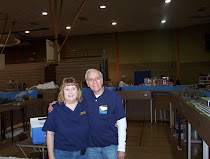High Speed Rail Keeps Train Markers on Track.
By: Paul Glader
http://online.wsj.com/article/SB10001424052748703790404574473534243457304.html
"Ten years in the making, Russia's state-owned railway is testing eight aerodynamic trains that in December will rush travelers from here to Moscow in less than four hours. With fancy kitchens and leather seats in first class, the Sapsans (Russian for peregrine falcons) mark a change in Russia's egalitarian rail tradition."
"More broadly, though, Russia's new trains mirror a global push in high-speed rail that spans from China to the U.S., an effort that is buffering Siemens AG, Hitachi Ltd., Bombardier Inc. and other industrial giants against the economic slump."
"Global spending on trains, tracks and equipment is expected to reach €122 billion ($182 billion) this year, flat with last year, but up 18% from 2004, according to Unife, an international trade association. It projects that the figure will rise to €150 billion by 2016, propelled by stimulus projects and environmental concerns."
"Rail spending "has a short-term effect on unemployment as well as a longer-term effect on economic growth," says Michael Clausecker, Unife's director general. Rail lines, he says, tend to anchor development of new towns, companies and jobs while increasing travel between cities."
"A high-speed rail link between Madrid and Barcelona that opened last year has stolen former air travelers, cutting daily flights between the cities in half to 35. Spain plans to surpass Japan with the world's largest network of high-speed routes in 2010, and India and China plan to surpass Spain before long. France hopes to double its high-speed track to about 2,500 miles by 2020."
"Denmark is shifting transportation funding from roads to public transportation, the bulk of which will be spent on rail.In the U.S., President Barack Obama has vowed to spend $13 billion over five years to build high-speed rail links between major cities, including $8 billion under the economic-stimulus plan."
"The spending is aiding the fortunes of train makers."
"Bombardier's rail-division revenue in the quarter ended July 31 rose 5% from a year earlier to $2.55 billion while total company revenue was flat. The Canadian manufacturer recently reported a $190 million order for 30 tram-trains for Karlsruhe, Germany, and a $2 billion contract to send 80 Zefiro high-speed trains to China by 2014."
"China "is making the strategic investments" to build a high-speed rail network and sustainable transportation system, says Jianwei Zhang, president of Bombardier China. The country wants to build "the most advanced rail network in the world.""
"Japan's Hitachi shipped six high-speed bullet trains to the U.K. this summer and plans to build rail cars there. Revenue for the unit that includes rail rose 19% for the fiscal year ended March 31, making the business one of Hitachi's strongest."
"Alstom SA's transportation sales increased 3% to a record €5.69 billion for the year ended March 31 as its order backlog climbed 13% to €19.51 billion. The transportation division, which makes up roughly 30% of Alstom's business, received a boost in train orders from Italy and the U.K. recently. The company projects continued strong demand, citing stimulus packages in the U.S., France and elsewhere in Europe, says Chief Executive Patrick Kron.Patrick Kron. The French company in March formed a joint venture to develop products in Russia, the largest railway market in Europe with 85,000 kilometers of electrified track and 1.3 billion passengers a year."
"And while General Electric Co.'s rail operation primarily makes locomotives for freight trains, executives plan to sell fuel-efficient locomotives for faster passenger railroads in the U.S., Mongolia, Kazakhstan and elsewhere. GE wants to sell Amtrak more engines that go as fast as 123 mph, replacing "20-year-old locomotive clunkers," says Stephan Koller, a spokesman for GE Transportation. Trains that are even faster are further on the horizon as they would require expensive track upgrades."
"For the Sapsan project, Russian Railways spent nearly $1 billion for its eight Siemens Velaro trains. "The market is really developing," says Edzard Lübben, the company's vice president for high-speed trains, sales of which are growing around 8% a year. "That's a huge growth rate during these times.""
"The Sapsans will trim the Moscow-to-St. Petersburg trip to three hours and 45 minutes from 4½ hours, running about 60 mph below their capacity because of difficulties upgrading tracks. The trip is expected to cost about $100 one way, which is roughly the same as the average plane fare."
""It makes everything more convenient," by removing airport security lines and the need to travel between an airport and the center of town says Irina Darienko, a delivery-operations specialist for Alcatel-Lucent in Moscow.She travels to St. Petersburg about three times a year for work and plans to ride the new trains."
"Russian Railways says its eight-hour "night trains" between Moscow and St. Petersburg will continue to offer service to budget travelers. The Sapsans will replace the faster trains that run during the day."
""I'm sure they'll push away aircraft," says Alexander Dumnich, a captain of the famous Red Arrow train, which was introduced by Joseph Stalin in 1931 and pressed into military service during World War II."
"Alexei Daibov, an auditor with PricewaterhouseCoopers in St. Petersburg, is more skeptical. "I travel by plane," he says, expressing but he hopes a price war will lower the cost of plane tickets."
Write to Paul Glader at paul.glader@wsj.com




